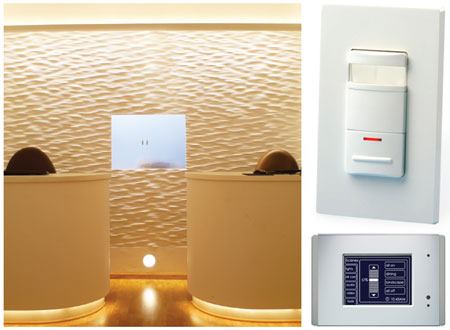Meanwhile, the maturation of DALI remains one of the better evolutionary developments in lighting controls. With universal standards for ballasts and other components, we are not far from being able to write simple specifications that result in competitively priced products and whole systems that are easy to program and commission. Several key products and partial systems were shown, suggesting a future where dimming is no longer an overly expensive word. Thank goodness the ballast companies are now making dimmable LED drivers as well as ballasts. They, too, are getting ready for the LED revolution, and they know that dimming is an essential part.
It’s the Economy There was an overall sense of economic concern that seemed to affect attitudes all around the show. While the booths seemed well manned, they all seemed smaller than in past years. The buzz was more reserved, the events a bit less lavish, and the awards programs seemed to end earlier. Also, attendees seemed less inclined to stay the entire week, and a lot of people were seen “working” the show quickly to get more done in less time.
Every Other Year? For a number of years now, experienced North American lighting geeks, many of whom make biennial trips to Europe to attend one of the other lighting shows, question the need for annual Lightfair shows. Attending Lightfair and European shows in alternating years is widely believed to be the best strategy for staying up-to-date with lighting style as well as technology. Many choose to rotate the New York Lightfair with Frankfurt.
Not surprisingly, lighting manufacturers also recognize the potential of a biennial show. For a large manufacturer with a big booth, numerous attendees and a big entertainment program, the cost of each Lightfair easily can be hundreds of thousands of dollars. It is no secret that several lighting conglomerates have been lobbying to have Lightfair every two years.
But before we leap off that cliff, it helps to remember the role of Lightfair in the lighting industry. The successor to Lighting World and other trade shows, Lightfair is first and foremost a money-making enterprise. A healthy annual income from Lightfair is needed to keep the North American engines of lighting education, standards, and professional development going. Co-owned by the Illuminating Engineering Society of North America (IESNA), the International Association of Lighting Designers (IALD) and AMC Trade Shows, Lightfair provides about a quarter of the IESNA’s annual budget, and a whopping 80 percent of the IALD’s income.
Then, there are the practical considerations of running a trade show. As with other similar events, convention hall reservations are made years in advance and planning takes more than a year. Lightfair’s bargaining position at the Javits Center in New York improved when an every-other-year, long-term commitment was made. There also is a concern to alternate geographic locations of Lightfair—currently held only in New York and Las Vegas—to better serve the largest possible lighting community. There are not a lot of locations where Lightfair can draw the 15,000 to 20,000 people needed for a successful show. A lot of thought goes into the commitments for future Lightfair trade shows, lest one bad year could dramatically affect our industry’s lighting associations.
I think the best argument for an annual show is the rapid change in lighting technology. To me, the biennial idea is as dead as the incandescent lamp when it comes to my needs as lighting professional. In the next 10 years, lighting most likely will change 100 percent, and not much seen today will still be around in 2018. Before the LED, I might have agreed that alternating year shows was probably valid, given the stagnancy of conventional sources and the lack of inspired product evolution in the 1990s. But solid-state lighting changes that, and every year 10 percent of the industry is going to change. I do not think it is possible to keep up with this pace by attending a trade show every two years. Lightfair is properly positioned to carry us through the upcoming LED revolution, and it deserves the lighting community’s ongoing support.
